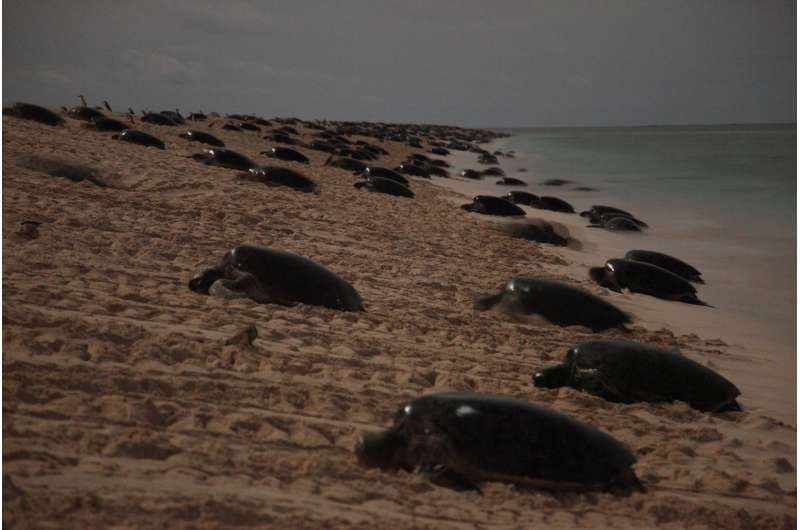Too many turtles? Scientists may have solved the mystery of Raine Island

Why do so few turtle eggs hatch on Raine Island, the largest and most important nesting site for green turtles in the world? It may be that 'safety-in numbers' is just the opposite to the truth for turtles, according to researchers from the Queensland Government Parks and Wildlife Service and the University of Queensland, Australia.
As a tiny coral island that lies between Australia and Papa New Guinea, Raine Island should be the perfect nesting ground for green turtles, globally listed as a vulnerable species. But despite having a broad sandy beach fringed with protective coral and no land-based predators, the rate of successful hatches is now less than 30% even in nests that are undisturbed by later nesting turtles, with many turtle embryos dying early during incubation.
At first, seawater flooding the nests during high tides was thought to be the cause: "We noticed that at very high tides pools of seawater would appear in depressions in areas of the beach that turtles used for nesting", says researcher Dr David Booth. Consequently, a bulldozer was barged out to the island in 2014 to raise a section of the beach by 1-1.5 metres. But despite the sea level remaining well below the nests in this area, the hatching rates were still extremely low in that year.
However, during the following year the hatching success almost doubled. What had changed? "Fewer turtles laid nests on the island that year", explains Dr Booth, "suggesting that a density-depending effect was limiting hatching rates even in nests that remained undisturbed throughout incubation, rather than the environmental conditions".
"Because the nests generally remain undisturbed by other nesting turtles, the most likely explanation is to be low oxygen or high carbon dioxide levels, or an increase in disease-causing microorganisms" says Dr Booth. Larger numbers of nests would mean that oxygen levels below the sand would be used up more quickly - potentially resulting in asphyxiation. The sand of the beach on Raine Island has been tested for oxygen permeability and found to be similar to highly successful turtle rookeries. Therefore, the physical properties of the sand itself cannot be limiting the amount of oxygen available.
Alternatively, a high density of nests may cause bacteria and fungi build up to higher levels, before penetrating through the eggshells and killing the turtle embryos.
Dr Booth intends to test this by investigating whether pumping air into the nests using aquarium aerators can boost the hatching rate. If his hypothesis is correct, it could explain why a similar phenomenon sometimes occurs in other turtles that nest at high densities, such as Oliver Ridley turtles.
More information: These results are being presented on Thursday 7th July at the 2016 Annual Meeting for the Society for Experimental Biology, held in Brighton.
Provided by Society for Experimental Biology


















